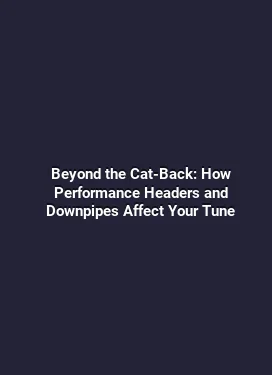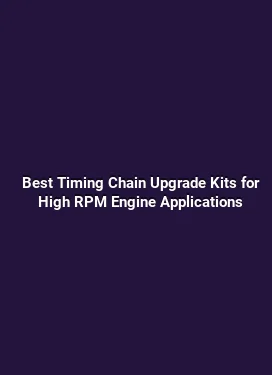Forced Induction Face-Off: Turbocharger vs. Supercharger for Maximum Street Power
Forced induction has long been the cornerstone of unlocking significant power gains from modern engines. When aiming for maximum street performance, the choice between a turbocharger and a supercharger isn't just about raw horsepower figures; it is about how the system behaves in everyday driving, how it integrates with engine management, and how tuners craft maps that maximize tractable power without compromising reliability. This examination dives into the core differences in design philosophy, piping and charge air paths, transient response, heat management, fuel and ignition strategies, and practical tuning approaches that matter on real-world streets.
Fundamental Differences: How Each System Produces Boost and Why It Matters on the Street

Turbochargers derive their boost from exhaust energy. A turbine is driven by exhaust gases, spinning a compressor that forces ambient air into the intake with increased pressure. The fundamental advantage of a turbo is efficiency at higher engine speeds, where exhaust energy is abundant. On the street, this translates into a broad peak in power that grows with rpm, often accompanied by a lag that can be mitigated with modern boost control strategies and twin-scroll or multi-variable wastegate configurations.
Superchargers, by contrast, rely on the crankshaft (or an accessory belt) to drive the compressor directly. This results in immediate boost response and excellent low-end torque, which is particularly valuable for street acceleration and daily drivability. The downside is parasitic loss from the belt drive and a generally flatter efficiency curve at higher RPMs, where the turbo might outpace it in terms of absolute airflow. Understanding these baseline traits sets the stage for interpreting how each system behaves under real-world throttle input and gear selection.
Performance Profiles on the Street: Torque, Responsiveness, and Temperature Management
Both systems aim to increase the engine’s effective displacement by pressurizing the intake charge, but the way they shape the torque curve is different. A turbocharged setup tends to push torque into a wider RPM band as boost builds with exhaust energy, which can create a strong mid-range and top-end surge once the charge is stabilized. For street use, this means a tunable torque band that can outperform naturally aspirated rivals in top gears and high-speed merges, provided boost is managed to avoid excessive heat and knock tendencies.
A supercharged system delivers rapid boost onset, often resulting in a pronounced low-to-mid torque spike that makes daily driving feel dramatically more muscular. The trade-off is potential belt slip, pulley-driven inertia, and heat from continuous drive under load. Effective street-driven strategies often involve selecting a pulley ratio that keeps boost within a safe window at low speeds, combined with intercooling or charge cooling to maintain charge air temperatures within optimal ranges for consistent performance.
Charging Pathways and Heat Mitigation: Why Air Temperature and Airflow Velocity Matter

Charge air temperature plays a crucial role in engine efficiency and knock resistance. A cooler, denser intake charge yields higher oxygen content and allows the ignition timing to be advanced safely for more torque. Turbo systems commonly incorporate intercoolers, aftercoolers, or charge coolers to reduce air temperatures after compression. The intercooler’s effectiveness depends on core size, airflow across the core, and ducting efficiency. On the street, a compact intercooler with efficient routing can minimize pressure drop, helping to preserve throttle response and reduce turbo lag in the case of smaller turbos.
Supercharged configurations also benefit from effective heat management, though the heat load is more continuous given the mechanical drive. Heat shielding, routed coolant lines around the compressor housing, and properly sized radiators or heat exchangers help maintain consistent performance. In both systems, heat soak during stop-and-go traffic is a common challenge, so tuning strategies often incorporate progressive boost limits that retract boost once the car idles for a period or reaches a prescribed coolant temperature.
Engine Management and Tuning: Crafting Maps for Street Survival and Peak Power
Approaching tuning for street-driven forced induction requires balancing power, reliability, and drivability. This means materializing a robust fueling strategy, precise ignition timing, and smart boost and torque management that respond predictably to throttle input, inlet air temperature, and engine load. Modern engine management systems use a combination of boost control solenoids, wastegates, and electronic throttle control to shape the boost curve. The tuning process typically starts with data logging, mapping the baseline fuel delivery and ignition timing in closed-loop operation before introducing boost in small increments to validate fueling stability and knock protection.
Fueling strategies must account for the higher air density provided by the forced induction system. This often entails higher-precision fuel metering, calibration of injector flow, and ensuring that the fuel system can sustain elevated pressure without starving the engine due to dynamic fuel demand. For turbo applications, boost ramp rates are critical to avoid sudden surges that can overwhelm the fuel system. For superchargers, the priority shifts toward managing the belt-driven parasitic load while maintaining a stable air-fuel ratio across the torque band.
Ignition Timing and Knock Control: Staying Within Safe Margins While Pushing Power
Ignition timing must be advanced cautiously as boost rises, yet the optimal timing varies with air temperature, engine design, and fuel quality. Knock control is essential; once detonation is detected, timing is pulled back across the affected cells, and fuel and boost are adjusted to prevent engine damage. In street-driven setups, it’s common to employ progressive timing strategies that add timing with increasing load and RPM, while using knock sensors and adaptive dwell strategies to protect the engine under varying fuel grades and ambient conditions.
Gauging the right air-fuel ratio under boost is another critical pillar. While a richer mixture can help prevent knock, it also reduces thermal efficiency if overdone. Tuners often optimize for stoichiometric targets under cruising but switch to rich boost maps for acceleration or track-like conditions. Real-world calibration involves road testing, data logging, and validating performance across a wide range of operating temperatures and fuel qualities.
Architecture and Installation Considerations: Piping, Pulleys, and Backpressure
When selecting between turbo and supercharger kits, installation complexity, packaging constraints, and the vehicle’s intended use come into play. Turbo installations require exhaust routing that must be carefully planned to minimize backpressure and heat transfer to the intake tract. Wastegate and blow-off valve placement affect response characteristics and turbo flutter tendencies, which can influence both driving feel and long-term reliability. Additionally, downpipes, intercoolers, and charge pipes should be designed to minimize pressure drops and hot air recirculation that would erode performance gains on the street.
Supercharger kits typically present a simpler path for installation, especially on platforms with existing belt-driven infrastructure. However, the belt system must be sized to handle the extra load, and pulley choices directly impact the maximum boost available at various RPMs. Accessory drive layout, alternator heat, and belt tensioning become practical considerations that influence reliability and maintenance schedules. Both routes benefit from a well-integrated engine management approach, a robust fueling supply, and dependable cooling strategies to sustain performance across daily use and occasional spirited drives.
Sensor Suite and Diagnostics: Data, Mapping, and Safe Operation
Modern forced induction setups rely on a dense array of sensors to calibrate air, fuel, and timing in real time. Manifold absolute pressure (MAP) sensors, intake air temperature (IAT) sensors, and throttle position sensors feed the ECU the information needed to shape boost strategies. Wideband oxygen sensors provide a precise read on air-fuel accuracy, enabling high-fidelity corrections under boost. For street tuning, logging these signals over hundreds of miles helps establish stable baselines and reveals edge cases such as humidity or altitude shifts that influence air density and combustion behavior.
Diagnostics play a crucial role in preventing drivability issues. Error detection on boost control solenoids, wastegate operation, and sensor health ensures that the system behaves predictably during long drives. A disciplined approach to maintenance, including inspecting intercooler fins, piping connections, and belt wear, helps maintain consistent power delivery and avoids the kind of reliability surprises that can frustrate daily drivers.
Real-World Scenarios: Tuning for Daily Driving vs. Weekend Fun
In daily driving, the objective often centers on seamless throttle response, smooth power delivery, and consistent performance across varying fuel qualities. Turbo systems can excel here by delivering substantial mid-range torque with properly tuned boost curves that avoid abrupt throttle transitions. A thoughtfully tuned turbo setup will provide a broad, usable power band that feels natural in normal traffic yet responds with a measured surge when a lane change or merge is required.
Weekend enthusiasts and track-focused drivers might push the envelope, seeking higher boost targets, more aggressive timing strategies, and optimized intercooling performance. In these cases, the tuning strategy emphasizes limiting heat soak, ensuring the cooling system remains within safe operating temperatures, and employing safety margins in the event of coolant temperature spikes or fuel pressure fluctuations. A balanced approach recognizes the need for reliability while still delivering the thrill of peak power when conditions permit.
Maintenance, Longevity, and Practical Upgrades
Durability starts with proper lubrication and cooling. Forced induction places additional thermal and mechanical stress on rotating assemblies and bearings, so regular oil analysis, proper oil temperature management, and a cooling system capable of handling the extra heat become foundational. Upgrades such as larger intercoolers, upgraded pumps, resistant intake piping, and advanced intercooler fans can extend longevity and maintain performance as miles accumulate.
From a driving perspective, tire choice and suspension setup influence how effectively the power is translated to traction. Street-focused builds often pair power upgrades with grippy tires and harmonized suspension tuning to ensure that the increased torque translates into usable acceleration rather than torque steer or wheel spin. A holistic approach—covering engine, drivetrain, tires, and chassis—produces the most satisfying street experience when a forced induction system is engaged.
Choosing the Right Path: Turbo vs. Supercharger for Your Vehicle and Driving Style
For drivers who value immediate response, predictable torque delivery, and simple daily usability, a well-calibrated supercharger can deliver a compelling experience with less perceived lag. In contrast, those seeking high-end power across a broader RPM range, especially at higher speeds or in applications where exhaust energy is abundant, often find a turbocharged solution more favorable due to its efficiency and potential for higher peak power with careful tuning and heat management.
The ultimate decision hinges on the vehicle platform, engine displacement, intended use, fuel quality, and the willingness to engage in a sophisticated tuning process. A robust plan involves selecting a reputable kit, ensuring compatibility with the factory fuel system and ECU, and committing to a data-driven tuning workflow that respects engine limits while extracting maximum street-legal performance.






